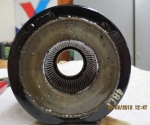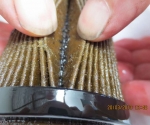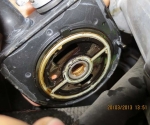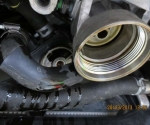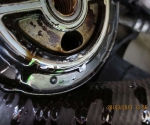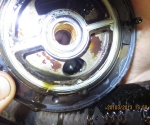PROBLEM:
Our reconditioned engine developed a cold start “loud” noise two months after start-up.
Up to that time, three weeks ago, the engine was reported as running like new.
CAUSE:
This engine had been reconditioned following infrequent oil changes and turbo bearing damage resulting from the degraded oil condition. The turbo had been replaced when the reconditioned engine was fitted.
Our failure analysis proceeded as below.
The first thing checked was the oil. It was very dark in color and had an old-oil smell. The sump plug was removed and the oil drained into a clean container to reveal an almost black oil condition.
The second item removed was the oil filter element. This engine, like most late model designs, has the paper element housed in a unit attached to a small oil cooler through which the oil flows before entering the engine oil gallery system. The purpose of this is to bring the temperature of the oil up to operating temperature and to hold it there during running. To do this heat transfer, a considerable surface area exists within a radiator-like core and this area collects residue over the normal operation of the engine. Whenever a major failure occurs within an engine, such as a failed bearing, the migration of metalic material from the bearing lodges inside the engines’ oil gallery system. The oil cooler is particularly good at capturing such material. It will also block up with a black gell from old engine oil.
Unfolding the paper element revealed a considerable amount of debris and flakes of carbon from within the external oil lines and we suspect also from within the oil cooler. Some metalic flakes of material existed in this paper element and several carbon flakes, 5mm square, sat on the surface..
So, the oil filter did its’ job didn’t it?
Oil filtration systems have an in-built filter by-pass to the oil gallery should a total filter blockage occur. So, no, an oil filter can only function within the design parameters set by the engine designer who has a right to expect oil to be maintained and not have to cover abnormal situations such as we were looking at.
Based on the material found in the oil system discussed above, it is reasonable to now expect that debis from the first failure has re-entered the “new” engine as a result of fitting unclean accessories. The engine noise will be one of several possibilities:
The modern engine has a very large number of small diameter holes through which oil feeds various pressure-sensitive assemblies. Some of these drillings are 1mm in diameter and exposed to failure should oil changes not follow the manufacturers’ recommendations. They are especially exposed to dirt as discussed above.
Examples:
Camshaft advancing mechanisms are operated from oil pressure. Should they become partially or fully blocked, these Variable Valve Timing (VVT) systems will rattle should the oil reservoir within them bleed down.
Where camshafts are chain driven, a hydraulic assembly maintains tension on the chain(s) to reduce engine noise. Again, where material is floating around the oil gallery system, these oil feeds can become partially or fully blocked. The result is considerable noise and, in extremes, serious engine damage.
CURE:
At the time of writing this article, the engine has not been removed and stripped down for inspection. But it is reasonable to suggest that dirty accessories have been the cause of this event.
The six rules of engine work: Check, Check, Check, Clean, Clean, Clean.


